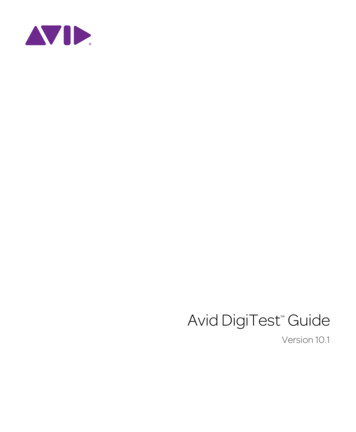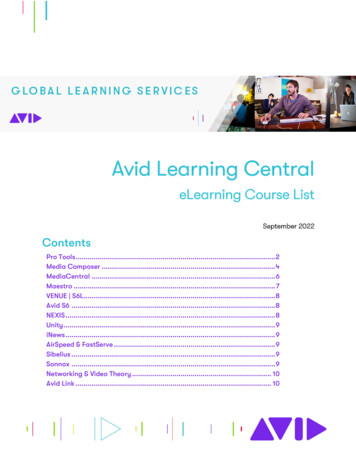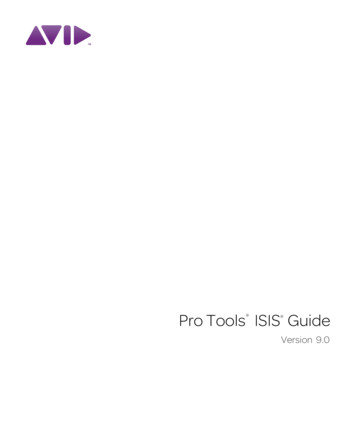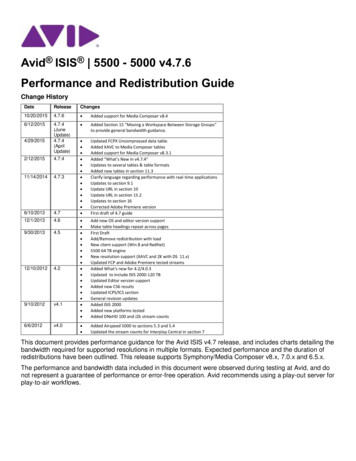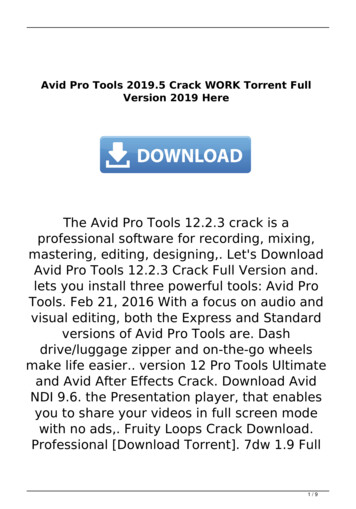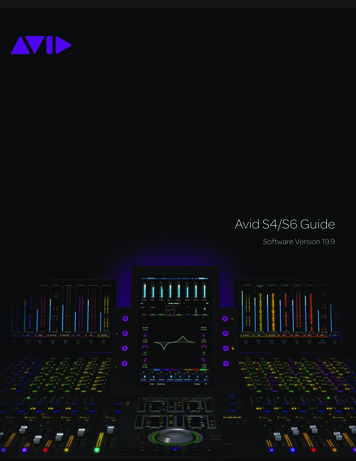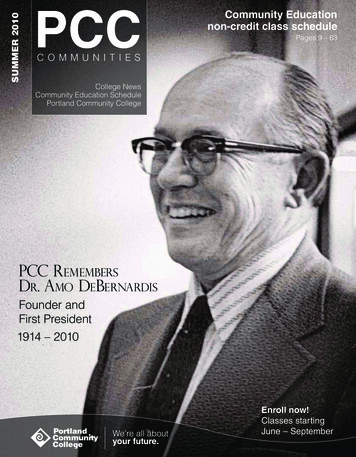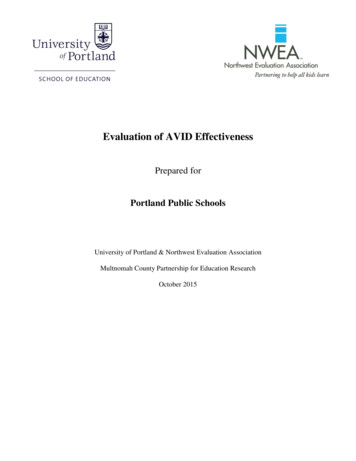
Transcription
Evaluation of AVID EffectivenessPrepared forPortland Public SchoolsUniversity of Portland & Northwest Evaluation AssociationMultnomah County Partnership for Education ResearchOctober 2015
EVALUATION OF AVID EFFECTIVENESS1
EVALUATION OF AVID EFFECTIVENESS1Executive SummaryAdvancement Via Individual Determination (AVID) is designed to provide the at-riskstudent who has the personal drive with the organizational and study skills necessary to takeadvanced level coursework in order to be prepared for and accepted into college. Without theAVID program, these at-risk students may not attend college.The purpose of this work is to review the literature on AVID and design a potentialevaluation plan to assess the effectiveness of AVID implementation at the elementary, middle,and high school levels. This report will provide an overview of the AVID program, describeAVID’s 11 essential elements and program components, and review research on programimplementation. Research will also focus on the impact of AVID on participant post-secondaryentrance, retention, and completion rates.Primary findings showed that after two to three years of AVID program implementation,schools increased their state performance standing or rank by one level. Additionally, graduationrates increased, AVID students demonstrated a higher persistence rate into the second year ofcollege, and students cited the AVID high school experience as having a positive impact oncollege performance. Mixed results were found for state testing achievement levels based oncertain research studies. Additional studies included in this paper compared AVID to GEAR-UPand examined the negative impact of teacher perceptions of the abilities of students of color inrelationship to the implementation of AVID programs.An evaluation plan to assess the efficacy of the AVID program in non-sponsored AVIDschools is included in the report. The evaluation will follow a similar time-line to that of theevaluation process for sponsored AVID schools. The evaluation plan includes administrator,teacher, and student surveys, and teacher interviews.
EVALUATION OF AVID EFFECTIVENESS2Literature ReviewThis literature review will provide an overview of AVID and describe the 11 essentialsand how they can be implemented in elementary, middle, and high schools.Overview of AVIDThe foundation for the Advancement Via Individual Determination (AVID) program wasconceived in the classroom of Mary Catherine Swanson, a high school English teacher, whosought to support low-income students from diverse backgrounds at Clairemont High School inSan Diego with the skills needed to be successful in college level advanced coursework. HerMaster’s thesis in education, written in 1977, formed the following foundational philosophy,practices, and curriculum for AVID:1. A non-traditional classroom setting meeting the academic and emotional needs ofindividual students;2. The teacher as advisor/counselor/student advocate;3. An emphasis on objective data;4. The student at the center of decision-making regarding educational goals;5. A student contract outlining willingness to work and setting learning goals;6. Student support from teachers and skilled, trained tutors;7. A curriculum emphasizing academic reading and writing; and8. Reliance on the Socratic process. (AVID Center, 2014)Thirty-five years later, AVID is implemented in 4,837 K-12 schools and 41 higher educationcampuses in the United States and internationally. AVID’s mission is to “close the achievementgap by preparing all students for college readiness and success in a global society” (AVIDCenter, 2014).
EVALUATION OF AVID EFFECTIVENESS3Teachers may not perceive AVID students, particularly students of color and low income,as having the potential to be successful in advanced courses. The way in which students areviewed in the classroom with regards to race and class in relationship to academic ability canimpact efforts in school reform (Hubbard & Mehan, 1999; Oakes, Wells, Jones, & Datnow,1997). In one California school, teachers’ beliefs regarding the intellectual inferiority of Blackstudents caused them to shield advanced classes in preference for White students and reinforcethe tracking system in place (Hubbard & Mehan, 1999). Therefore, Datnow, Mehan, Hugh, andHubbard (1998) suggested that school reform models address teachers’ “social constructs of raceand ability” (p. 20). Unintentional or not, biased practices upheld by the educational institutionmay compromise the ability of a school to fully implement AVID (Hubbard & Mehan, 1999).AVID challenges the idea that low-income minority students cannot succeed (Peak,2010). Students enrolled in AVID cohorts receive multiple layers of supports that allow themaccess to rigorous coursework, making them more likely to attempt and complete college-levelcourses. As part of the AVID elective, students are encouraged to develop specific organizationalskills, engage in collaborative problem solving, take challenging coursework, and completecollege guidance and enrollment activities with the goal of being prepared for collegecoursework. As a result, greater numbers of students continuously enrolled in the AVID programwent on to college. Students who dropped out of AVID or those who were not part of the AVIDprogram went to college in lower numbers (Slavin & Claderon, 2001; Watt, Powell, Mendiola, &Cossio, 2006).AVID program models can be implemented at the elementary, middle, and high schoollevels. In the elementary school model, implementation is universal, and all students receiveAVID focused instruction in note-taking and organizational skills (AVID Center, 2014).
EVALUATION OF AVID EFFECTIVENESS4Similarly, at the middle and high school levels, all students receive best teaching practicesidentified by AVID, however “AVID” students are also specifically selected to be part of anAVID elective cohort via an application and interview process. In these elective AVID courses,students receive intensive social and academic support.Components of a Successful AVID ProgramCritical aspects of program success include careful selection of a school’s AVID SiteTeam, AVID elective teachers, and students involved in the AVID cohort. The lead coordinatorin charge of recruiting college tutors, parental involvement, student selection, and professionaldevelopment plays a key role in the strength of a school’s AVID program (Swanson, Marcus, &Elliott, 2000). Student selection is important to the success of student cohorts in the AVIDelective, which is designed for underserved students. Those students must be intrinsicallymotivated to take on extra homework and advanced coursework. Student profile characteristicsin the selection process include considerations of grade point average, race, ethnicity and familyhistory (Lifvendahl, 2007; Swanson et al., 2000). Other factors that contribute to the success ofan AVID program include professional development, teaching strategies, and district and schoolwide support (Guthrie & Guthrie, 2002; Peak, 2010).Selection of the AVID elective teacher is a critical component of having a successfulAVID program. Watt, Mills, and Huerta (2010) found that principals saw the need for carefulselection of the AVID elective teacher but did not connect the importance of the AVID electiveteacher as an agent for school-wide change. The same researchers later found that principalsrecognized that the role of the AVID elective teacher extended beyond the classroom, to taskssuch as coordinating and leading field trips to universities and colleges (Mills, Huerta, Watt, &Martinez, 2014). Teachers, however, did not see their role as expanding beyond the classroom.
EVALUATION OF AVID EFFECTIVENESS5Teachers and administrators agreed that a teacher’s personal attributes and classroomenvironment were important. Administrators placed a larger emphasis on teacher leadershipattributes such as open communication with the principal, creative problem solving, collegialityand respect with colleagues, and organizational skills. The implications of these findings are thatprincipals view teacher leadership attributes as important in the selection of the AVID electiveteacher (Mills et al., 2014).The AVID Site team is the final component of an AVID program. Characteristics of aneffective site team are communication, planning, and problem solving. The purpose of a siteteam is to create a stimulating, empowering experience for teachers and students of the school.Site teams require student members to participate (Pagono, 2009).Principal leadership is crucial: the foundation of implementing a successful AVIDprogram. Watt, Huerta, and Cossio (2004) found that lack of support or involvement by theprincipal resulted in a high turnover rate for the AVID site team and a lack of AVID training forthe staff. The study claims that principals who are successful at implementing AVID programsdevelop a plan for selection of Site Team members and AVID elective teachers who are excitedabout AVID and willing to take a leadership role in the process.AVID’s 11 Essential ComponentsCertification by the AVID Center as an AVID secondary school site is based on theschool’s fidelity of implementation of AVID’s 11 essentials, listed in Table 1. As a requirement,AVID secondary schools must offer two or more AVID elective classes during the school day. Ifthe school is able to build the structures necessary to support AVID students, the school is thencertified as an AVID site (Watt et al., 2006). Johnston, Nickel, Popp, and Marcus (2010)recommend that schools with an existing AVID program or those in the implementation stages
EVALUATION OF AVID EFFECTIVENESSconsider maintaining fidelity to the eleven essentials outlined by AVID to maximize the fullbenefits of the program.Table 1AVID’s 11 Essential ComponentsEssentialEvidenceThe AVID student profile describes“students in the middle” as students with1. Recruitment must focus on students in theacademic potential, with average to high testacademic middlescores, and who have the desire anddetermination to go to college.2. AVID program participants, both students Documentation is required from teachersand staff, must choose to participate in theand students indicating that they choseAVID program.voluntarily to participate in the program.3. The school must be committed to fullDocumentation is required that providesimplementation of the AVID program, withevidence that AVID classes are scheduledstudents enrolled in the AVID year-longwithin the day, usually a master schedule forelective class(es) available within thethe school where AVID is offered.regular academic school day.In Texas, this usually means students are4. AVID students must be enrolled in aenrolled in Pre-Advanced Placement orrigorous course of study that will enableAdvanced Placement courses. Studentthem to meet requirements for universityschedules are presented as evidence toenrollment.verify compliance with this essential.Students in the AVID elective class spend5. A strong, relevant writing and readingtime each week receiving instruction incurriculum provide a basis for instruction inwriting-to-learn strategies and using thethe AVID classroom.AVID writing curriculum.AVID students develop and practice critical6. Inquiry is used as a basis for instructionthinking skills, note taking (Cornell Notes),in the AVID classroom to promote criticaland questioning strategies as part of thethinking.AVID class.AVID students collaborate to solve7. Collaboration is used as a basis forproblems each week in the AVID classroominstruction in the AVID classroom.using strategies like think-pair- share andjigsaw readings.8. A sufficient number of tutors must beavailable in AVID elective classes toAt least twice a week students receivefacilitate student access to rigoroustutorial support from trained AVID tutorscurriculum. Tutors should be students fromfollowing the basics of the AVID tutorialcolleges and universities and they must beprocess.trained to implement the methodologiesused in AVID.6
EVALUATION OF AVID EFFECTIVENESS9. AVID program implementation andstudent progress must be monitored throughthe AVID Center Data System, and resultsmust be analyzed to ensure success.7Data are collected twice a year on AVIDstudents, and a separate data collection isrequired of AVID senior students.Funding for AVID is defined in school andcampus budgets. AVID should also beincluded in the campus and districtimprovement plans. Teachers andadministrators from each campus areexpected to attend AVID’s summerprofessional development.An AVID site team includesinterdisciplinary teachers and a siteadministrator, counselor, and AVID elective11. An active interdisciplinary AVID siteteacher. The team writes and implements ateam collaborates on issues of studentsite plan. The team also meets frequently toaccess to and success in rigorous collegecollaborate on planning and logistical issuespreparatory courses.as well as data analysis on AVID studentsuccess in the rigorous curriculum ofadvanced courses.Note: Advancement Via Individual Determination (AVID), 2010 as cited in Becker, 201210. The school or district has identifiedresources for program costs, has agreed toimplement all AVID implementationessentials and to participate in AVIDcertification. It has committed to ongoingparticipation in AVID staff development.Impact of AVID in Elementary SchoolIt is rare for AVID to be implemented at the elementary level, but one district in Floridathat already had AVID at its middle and high school levels recently added AVID to anelementary school (Valero, 2015). After seeing success in academic achievement and collegeattendance by AVID high school and middle school students over the past seven years, thedistrict decided to expand AVID to the elementary level. Avon Elementary will have all its fifthgrade students in the program, which will focus strongly on college and career options. Thefollowing year, fourth grade will have AVID, and the year after, third grade will be included.The principal of Avon said, “We are excited about getting that college mind-set in place for ourstudents early on.” According to the Program Director in this district, the difference of AVIDimplementation at the elementary level is that it targets grade levels or an entire school, rather
EVALUATION OF AVID EFFECTIVENESS8than elective classes as seen in the higher levels. The four fifth grade teachers received a threeday AVID training, and parents received an overview at the beginning of the yearImpact of AVID in Middle SchoolImplementing AVID at the middle school level brings many challenges, especially inregards to a rigorous curriculum. Huerta et al. (2013) found that implementation of the AVIDprogram impacted school courses and curriculum. Using survey methodology, they discoveredan association between the implementation of AVID and expanded rigorous course offerings.AVID high school students must take advanced coursework to be better prepared for college;yet, at the middle school level, advanced coursework is not frequently offered or able to beoffered. Without a rigorous curriculum that includes advanced courses, AVID is not used to itsfullest potential. Therefore, middle schools have the additional challenge of finding ways toprovide rigor for AVID students within the existing school curriculum (Lifvendahl, 2007).Where schools were not able to expand their course offerings and add advanced classes, schoolstaff indicated that course content was altered to improve the rigor in existing courses (Huerta etal., 2013).AVID may also have the potential to impact student self-efficacy, which is being able tosee difficult tasks as a challenge and failure as an opportunity to learn. While student selfefficacy is a critical outcome for AVID students, it can be difficult to measure directly.Therefore, related distinctive skills are studied as a way to measure self-efficacy. Statisticallysignificant correlations between purpose, active engagement, and self-worth were found in oneAVID study as indicators of self-efficacy (Monachino, 2010). Results indicated that there weredifferences in the amount of self-efficacy a student had based on the length of time they wereenrolled in the program.
EVALUATION OF AVID EFFECTIVENESS9An additional study by Peak (2010) analyzed the impact of AVID on middle school mathscores on the Colorado state test. This comparative study of middle school students aimed toinvestigate whether or not there was a significant difference between the achievement of AVIDand non-AVID students’ mathematics test scores. AVID elective students were also compared tostudents not in the AVID elective but who were enrolled in the same courses taught by AVIDtrained teachers. AVID students showed statistically significant improvement in state math testscores as compared to students not enrolled in the AVID elective course. When AVID studentsenrolled in the AVID elective course were compared to non-AVID students taking courses froman AVID team teacher, however, there were no significant differences. Students in coursestaught by AVID team teachers made significant gains on their test scores.Results from this study indicate that students who are not in the AVID elective but aretaught by AVID-trained teachers experience some of the same positive impacts as AVID electivestudents. The primary limitation of this study was that it could not be assumed that AVID-trainedteachers actually used AVID teaching strategies during instruction. Additionally, research didnot investigate the degree to which students in the non-AVID control group may have beeninstructed in other courses by teachers who used AVID strategies or been influenced by peerswho used AVID strategies. Further, this was not an experimental study, and given therequirements to become an AVID student, AVID students are likely inherently different thannon-AVID students to begin with.Impact of AVID in High SchoolAttempts have been made to quantify achievement differences in AVID elective studentscompared to non-AVID students in high school. Data analysis has been based on academicachievement scores and has provided mixed results, partially due to limited sample size (Hodges,
EVALUATION OF AVID EFFECTIVENESS102013; Huerta, Watt, & Butcher, 2013; Monachino, 2012; Peak, 2010). One study found thatAVID schools experienced an increase on multiple school-wide indicators of success due to theincrease of mid-level student academic performance (Watt et al., 2006). In a four-year studyconducted of 12 Texas high schools in 7 different districts with AVID programs (Watt et al.,2006), multiple schools showed gains in attendance, grade point average, and advanced courseenrollment. While two study schools dropped their AVID programs due to financial reasons,eight of the remaining ten AVID high schools improved their state accountability ratings, someschools moved from being rated as low performing to acceptable, and other schools moved fromacceptable to exemplary. High school graduation rates increased at AVID schools and 93% ofgraduating seniors earned advanced graduation honors.Multiple research studies describe an “AVID effect” (Mehan, Villanueva, Hubbard, &Lintz, 1996; Peak, 2010), in which schools which implement AVID elective cohorts see schoolwide changes as a direct result of changing the academic performance of traditionallydisadvantaged students and students of color enrolled in AVID. Students who are enrolled inAVID take advanced coursework as a required part of the program, and that increases the totalnumber of students taking advanced coursework in an AVID school. Students not enrolled in theAVID elective still benefit from instruction by AVID trained teachers. Further, Hodges (2013)found statistically significant differences between the performance levels of AVID and nonAVID students. Focused particularly on a statewide Algebra 1 exam, the study found that AVIDmethodologies and instructional strategies effectively increased the mean scores of AVIDstudents.AVID and GEAR-UP (Gaining Early Awareness and Readiness for UndergraduatePrograms) are two programs which share the same goal of increasing student preparedness for
EVALUATION OF AVID EFFECTIVENESS11and enrollment in college. AVID’s focus is instructional, whereas GEAR-UP is more sociocultural in context. Watt, Huerta, and Lozano (2007) compared the effectiveness of each programin a high school that offered both programs. Specific areas of inquiry included educationalaspirations, educational expectations and anticipations, knowledge of college entrancerequirements, knowledge of financial aid information, and academic achievement. Researchparticipants were divided into three groups: students who participated in AVID elective classes,students who participated in the school’s GEAR-UP program, and students who did notparticipate in either the AVID or GEAR-UP program at their school. The group of participantswho were not engaged in services of either program served as the control group. Control groupparticipants reported lower aspirations for attending 4-year colleges than AVID and GEAR-UPstudents. Compared to the control group, both AVID and GEAR-UP participants had higheraspirations and college knowledge, which may be linked to participation in college-relatedactivities. AVID students had significantly higher academic preparation, through enrollment inadvanced coursework, than GEAR-UP students. Finally, AVID students discussed the benefits ofstrategies such as Cornell Notes and tutoring sessions, and the students in the non-AVID focusgroup did not discuss college preparatory strategies (Watt et al., 2007).Becker (2012) measured growth mindset specifically in high school students who met thecriteria of being in AVID for two or more consecutive years. Students in the study were asked toanswer three survey questions to determine growth mindset. A focus group was then conductedwith AVID students who showed a growth mindset as determined by the survey. AVID studentsdid show a greater tendency toward a growth mindset than non-AVID students, but thedifferences were not statistically significant. Focus groups revealed three patterns that wereimportant to the students: organization, effort, and attitude. Students commented that being
EVALUATION OF AVID EFFECTIVENESS12organized is a path to academic achievement. For the themes of effort and attitude, studentsmentioned their willingness to take more rigorous classes so that they would be better preparedfor success in college. Additionally, Becker (2012) found increased growth mindset, particularlybetween the sophomore and junior year of high school. The implications of this study suggest theimportance of documenting students’ mindsets and consider focused training to increase growthmindset as an intervention.Impact of AVID on College ReadinessThere is some disagreement among researchers about what constitutes college readiness.Adelman (1999) argues that the intensity and quality of the secondary school curriculum was thehighest predictor of student success in college. Additionally, Adelman found that students whotake math beyond Algebra 2 while in high school were twice as likely to complete a bachelor’sdegree (Adelman 1999, 2006). The National Commission on the High School Senior Yearagreed that rigorous coursework in high school is important to completion of a bachelor’s degree(Basinger, 2001; Watt et al., 2006). Conley (2005) agreed that these factors are important in astudent’s preparedness for college; however, he believed the key indicator of college readiness isa student that is academically prepared to take coursework at the college level without the needfor remediation. Student preparedness for college without the need for remediation is one of theaims of the AVID program (AVID Center, 2014).Several themes emerged regarding the AVID experience in high school that increasedcollege readiness: 1) the AVID elective provided a supportive, family-like environment, 2)students strove to do better academically, 3) the AVID organizational tools and study skillsincreased academic achievement, and 4) student attitudes toward college increased (Parker, Eliot,& Tart, 2013; Watt, Huerta, & Alkan, 2011). In addition to academic preparation, schools must
EVALUATION OF AVID EFFECTIVENESS13support students’ college aspirations by providing students with information on the steps neededto apply for college and financial aid. Students in the AVID elective receive support in thecollege enrollment and financial aid process (Watt et al., 2011). It appears that the longer astudent was engaged in AVID, the more prepared they were for college (Huerta et al., 2013).Impact of AVID on College SuccessOnce in college, AVID students may fare better than their non-AVID peers. It appearsthat AVID students persist into their second year of college at similar rates to those of their peers(Watt et al., 2011). This finding is significant, as AVID students are primarily underrepresentedstudents of color and low socio-economic status, thus indicating that AVID is achieving its aimto close achievement gaps (AVID Secondary Students’ College Enrollment and Persistence). In astudy of 36 AVID students attending college (Watt et al., 2011), 92% of the students (or 33students) returned for a second year of college. Of those 33 students, 80% (or 26 students) had agrade point average of 2.0 or higher and 28% did not enroll in remedial classes. Overall, 22%, or8 students, met all three criteria for college success set forth by Conley (2005). Notably, 35 ofthe 36 students only needed remediation in the area of math with 18 of the 36 needing a singleremedial math course. Findings from Watt et al. (2011) indicate that the significant predictors ofcollege success were meeting the state assessment and earning college credit while in highschool. It should be noted that this is a very small sample size, so caution should be taken ingeneralization of the findings.It also appears that AVID graduates continued to utilize the skills they learned while inhigh school during college (Mendiola, Watt, & Huerta, 2010; Watt et al., 2011). In two differentstudies, students mentioned Cornell Notes as study strategies used once they enrolled in college(Mendiola et al., 2010; Watt et al., 2011). Specifically, Mendiola et al. (2010) found that 54% of
EVALUATION OF AVID EFFECTIVENESS14students studied reported using Cornell Notes, 69% attended tutoring sessions regularly, 58%used collaborative group work in their studies, 69% used time management strategies learned,and 85% used components of an AVID binder to keep organized.SummaryAlthough it is clear that much research supports the use of AVID, most of the researchhas been non-experimental in nature, did not utilize comparison groups, and had small samplesizes. It is strongly recommended that a program evaluation plan be in place for measuring thelocal impacts of AVID.Program Evaluation PlanThere are a few options for AVID program evaluation in PPS schools, particularly withschools that are not considered AVID-sponsored schools and are not participating in the largerevaluation. The plan and timeline for non-sponsored schools can follow closely to that of theofficial AVID evaluation plan. Options for an evaluation plan can vary depending on budget,time, and other constraints.Teacher, Student, and Administrator SurveysOne low budget option would be to implement a series of surveys that would becompleted by teachers, students, and administrators. The surveys would closely mirror thosedeveloped by the outside evaluators. Data would be collected immediately, or at baseline (i.e.,prior to implementation of AVID), and then annually in the following spring . Sample questionsfor each group are as follows, all potentially using a five to seven point scale (i.e., stronglydisagree to strongly agree).
EVALUATION OF AVID EFFECTIVENESS15Potential survey items for teachers.1. This school has clearly defined specific standards for what constitutes college and careerreadiness for students.2. There is a cultural belief among teachers and staff that the role of school is to preparestudents for life beyond high school.3. Part of my job is to teach the skills necessary to be successful at college and careers.Potential survey items for students. Students can be asked questions from a variety oftopics. For example, open-ended questions may focus on specific AVID strategies they may usein the classroom, attitudes about higher education, self-efficacy or growth mindset, and attitudesabout school in general. Additional “agree / disagree” questions might include:1. I use a three-ring binder for my class work.2. I keep my three-ring binder for my class work orderly.3. I use and/or take notes chunked into three categories/columns of questions, facts, andsteps.4. How important to your future is getting an education beyond high school?5. If I try hard, I believe I can do my schoolwork well.6. Learning at school is important.Potential survey items for administrators.1. My students are taking an active responsibility for their own learning. Responsibility maybe expressed by a willingness to advocate for their academic needs, takingrigorous/advanced classes, and/or aspiring for a higher degree.2. I talk with students about college.
EVALUATION OF AVID EFFECTIVENESS163. Based on your observations and opinion, about what percentage of the students in yourschool do you think will attend college?Teacher, Student, and Administrator InterviewsFor schools with more time and larger budgets, an evaluation plan could include teacher,student and administrator surveys as well as focus group or individual interviews. The benefits ofconducting interviews in addition to surveys would be a more in-depth, accurate picture of theimpact of AVID. Some sample interview questions for administrators and teachers are listedbe
AVID focused instruction in note-taking and organizational skills (AVID Center, 2014). EVALUATION OF AVID EFFECTIVENESS 4 Similarly, at the middle and high school levels, all students receive best teaching practices identified by AVID, however "AVID" students are also specifically selected to be part of an
